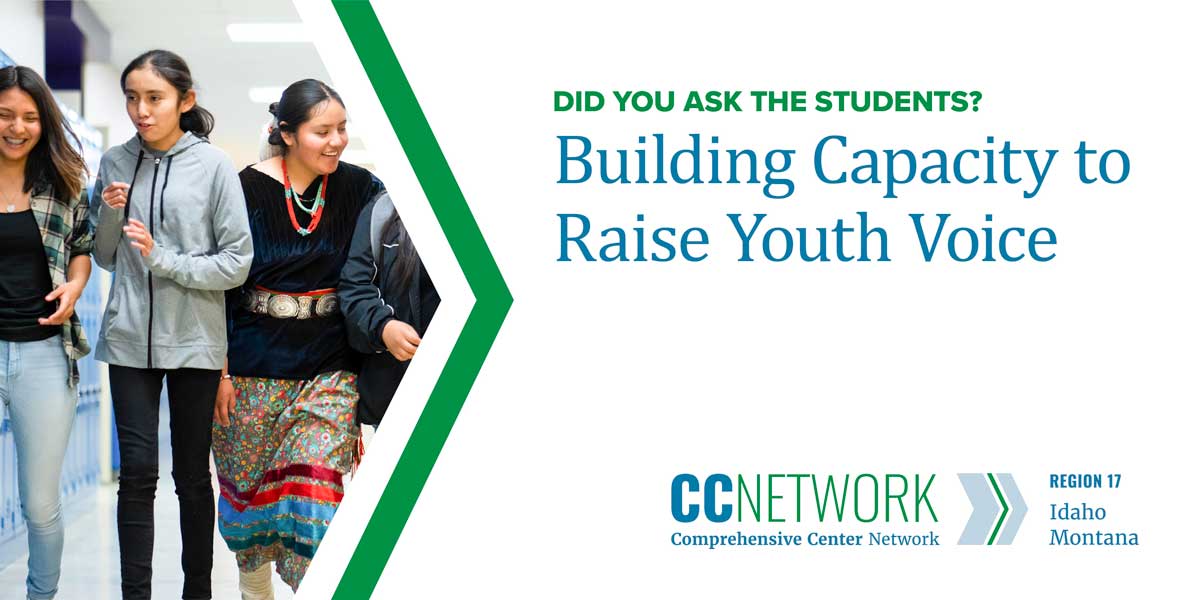
September 2022
How do we know if the programs and policies we develop meet the needs of students?
This is a question that education leaders often ask when making decisions that affect school communities.
One of the best, most simple ways to answer this question is by asking the students themselves. Beyond giving students a say in their learning conditions, youth voice supports effective and efficient implementation of reform initiatives1 and saves school systems time, energy, and money.2
This year, the Region 17 Comprehensive Center partnered with the Montana Office of Public Instruction (OPI) to center youth voice in building safe, healthy educational environments and whole child skill development.
Students First Requires Student Voice
In our work to support safe and healthy educational environments, Region 17 Comprehensive Center helped OPI build adult workgroups consisting of small and large districts, universities, and Department of Health and Human Services from across Montana.
To start, two workgroups focused on screening assessments to address student skills, suicide ideation, and school climate. The school climate workgroup created a framework and approach to support whole child skill development. As a part of this task, they developed the Whole Child Skill Development competencies, organized by student-level grade bands and adult skills that lay out the underlying conditions of support of a trusted adult in a safe and healthy environment. School and community leaders can use the competencies to analyze the current conditions in their settings and then create plans to build on strengths and target areas for improvement.
After creating the competencies and framework, the workgroups reorganized with the goal to support implementation across the state. However, to ensure implementation plans would benefit students, OPI realized the workgroups needed input from youth. At the same time, OPI recognized that the adults being asked to gather that input needed support to effectively incorporate youth voice.
Building Capacity to Raise Student Voice
To address the capacity need, we developed a three-part learning series titled “Engaging Youth Voice.” Our objectives were to:
- Describe the benefits of and plan for providing youth voice opportunities
- Investigate strategies for offering meaningful opportunities for student participation and decision-making within the school system
- Respond to the research and evaluate our thinking about the importance and effectiveness of implementing youth voice
As a part of this training, participants were introduced to the youth voice continuum. Developed by Region 17 Comprehensive Center with input from OPI, the youth voice continuum is a research-based tool that helps adults assess how deeply they implement youth voice in their current practice and strategize how to increase youth voice to facilitate shared decision-making. The continuum expands on the Ladder of Participation model3 by focusing on the power dynamic between adults and youth.
Download the Youth Voice Continuum
Moving forward, training participants are tasked with using this tool in their individual settings to assess their implementation of youth voice, plan for ways to increase authentic engagement, and involve students in decision-making processes.
Beyond the workgroups, OPI developed and supported a youth panel keynote session at the 2022 Montana Summer Institute. Students shared their thoughts and experiences from their own schools to advocate for greater student leadership and governing opportunities and leverage their knowledge to improve school environments.
As adults and youth continue to learn from one another, schools and communities across Montana will build their capacity to create learning environments that are safe and healthy for all students.
1 Silva, E. M., & Rubin, B. C. (2003). Missing voices: listening to students’ experiences with school reform. In E. M. Silva & B. D. Rubin (Eds.), Critical voices in school reform: Students living through change (1st ed., pp. 2). Routledge Falmer.
2 Beaudoin, N. (2005). Elevating student voice: How to enhance participation, citizenship, andleadership. Eye On Education.
3 Hart, R. (1992). Children’s participation: From tokenism to citizenship. Innocenti essays (4). https://www.researchgate.net